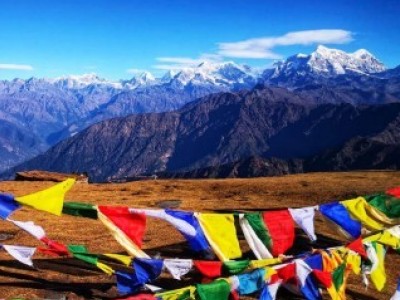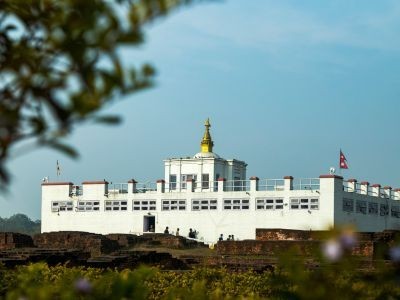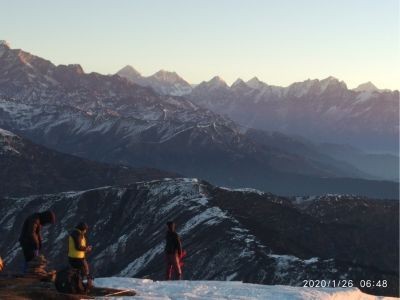Trekking Gear for Pikey Peak
The Pikey Peak trek, located in the lower Everest region of Nepal, requires proper preparation to ensure a comfortable and enjoyable experience. At 4,065 meters (13,343 feet), this trek offers spectacular panoramic views of eight 8,000-meter peaks, including Everest, Makalu, and Kanchenjunga. Unlike longer Himalayan treks, Pikey Peak can be completed in 5-7 days, making it perfect for those with limited time.
Your trekking gear forms the foundation of your preparation. Quality equipment doesn't necessarily mean expensive – it means appropriate for the conditions you'll face on the trail. When selecting your trekking gear for Pikey Peak, focus on durability, weight, and functionality.
- Backpack (40- 50L): A reliable backpack with proper support is essential for distributing weight evenly across your shoulders and hips. Look for one with multiple compartments for organization, padded shoulder straps, and a supportive waist belt.
- Trekking Poles: Significantly reduce strain on your knees during steep descents and provide stability on uneven terrain. The trail to Pikey Peak features varied terrain, from forested paths to rocky sections, making poles particularly valuable.
- Sleeping Bag (-10°C to -15°C): Nights in the Himalayas can be cold, especially at higher elevations. A good quality sleeping bag will ensure you stay warm throughout the night. Many teahouses provide blankets, but having your sleeping bag is more hygienic and guarantees comfort.
- Headlamp with Extra Batteries: Indispensable for reading in your teahouse room, making an early start for sunrise views, or navigating during the shorter daylight hours, especially if trekking during winter months.
- Rain Cover for Backpack: Weather in the mountains is unpredictable, and a sudden shower can soak your gear. A waterproof cover keeps your belongings dry and adds minimal weight to your pack.
Weather-Appropriate Clothing for Pikey Peak
Understanding the climate and temperature variations on the Pikey Peak trek is crucial for packing the right clothing. The trek can be done year-round, but each season presents different challenges and clothing requirements.
Spring (March-May) brings mild temperatures and blooming rhododendron forests, while autumn (September-November) offers clear skies and excellent visibility. Winter (December-February) means fewer trekkers but colder temperatures, especially at night. Monsoon season (June-August) is characterized by rain, leeches, and cloudy views, making it the least favorable time to trek.
The key to weather-appropriate clothing for Pikey Peak is layering. This approach allows you to adjust your clothing throughout the day as temperatures change. Mornings might start cold, warming up considerably during midday hiking, before cooling again in the evening.
- Base Layer: Moisture-wicking thermal wear that keeps sweat away from your body. Merino wool or synthetic materials work best, as cotton tends to retain moisture and can cause chilling when temperatures drop. Pack at least two sets so you can change into dry clothes at the end of each trekking day.
- Insulation Layer: A good fleece or down jacket provides warmth without excessive weight. Down jackets are particularly effective in the dry cold of the Himalayas, offering an excellent warmth-to-weight ratio. However, they lose insulating properties when wet, so a synthetic alternative might be better if you're trekking during wetter seasons.
- Outer Layer: Must be both waterproof and windproof to protect against precipitation and the strong mountain winds common at higher elevations. Look for jackets with sealed seams and good ventilation options for when you're exerting yourself on uphill sections.
- Trekking Pants & Shorts: Quick-drying, durable, and offering some stretch for freedom of movement. Convertible pants that zip off into shorts give you flexibility as temperatures change throughout the day. Pack at least two pairs.
- Gloves, Hat & Buff: A warm hat, gloves, and a buff or neck gaiter protect extremities that are particularly vulnerable to cold. UV protection is also essential at altitude, so include sunglasses and a wide-brimmed hat for daytime use.
Footwear Essentials
Your choice of footwear can make or break your trekking experience. The terrain on the Pikey Peak trek varies from well-trodden dirt paths to steeper rocky sections, requiring footwear that provides both support and protection.
- Trekking Boots: Boots with ankle support are recommended, especially for those less experienced with mountain hiking. The ankle support helps prevent sprains on uneven ground, while a sturdy sole protects your feet from sharp rocks. Waterproof boots are preferable, as you may encounter streams, morning dew, or rain. Before your trip, ensure your boots are well broken to avoid blisters.
- Sandals or Camp Shoes: Light sandals or camp shoes serve as ideal footwear for relaxing in teahouses and giving your feet a break from boots. They're also convenient for bathroom visits during the night without having to lace up your hiking boots.
- Woolen Socks & Liner Socks: Invest in several pairs of woolen or synthetic hiking socks that provide cushioning and moisture management. Some trekkers prefer using liner socks underneath their hiking socks to reduce friction and prevent blisters.
Altitude Sickness Prevention Items
While Pikey Peak doesn't reach the extreme altitudes of some Himalayan treks, at 4,067 meters, altitude sickness remains a concern for many trekkers. Understanding how to prevent and address altitude-related issues is an essential part of trek preparation.
Altitude sickness, or Acute Mountain Sickness (AMS), can affect anyone regardless of age, fitness level, or previous trekking experience. The key to prevention is proper acclimatization, which means ascending slowly and allowing your body time to adjust to the decreasing oxygen levels.
- Diamox (Acetazolamide): A medication that helps prevent altitude sickness by increasing respiration rate, which enhances oxygen intake. While effective, it should be used as a preventative measure rather than a cure. Always consult with a healthcare provider before using any medication, and be aware of potential side effects like tingling in the extremities and frequent urination.
- Water Purification Tablets: Staying properly hydrated is another crucial factor in preventing altitude sickness. The dry mountain air, combined with increased respiration and physical exertion, can lead to rapid dehydration. Carry water purification tablets or a reliable water filter to ensure you always have access to safe drinking water without having to purchase plastic bottles along the route.
- Electrolytes: Tablets or powders help replace minerals lost through sweat and maintain proper hydration. They can be added to your water bottle during trekking days to prevent dehydration and muscle cramps.
- First Aid Kit: Should include basic medications for headaches, fever, and gastrointestinal issues, as well as bandages, antiseptic ointment, and blister treatment supplies. While teahouses along the Pikey Peak route might sell basic medications, prices are higher and selection is limited, so it's best to bring your supplies.
Budget-Friendly Trekking Equipment
Trekking in Nepal doesn't have to break the bank. With some strategic planning, you can find budget-friendly trekking equipment that meets your needs without compromising on quality or safety.
- Affordable Down Jacket & Sleeping Bag: Kathmandu, particularly the Thamel district, is a haven for trekking gear. Numerous shops sell both genuine and replica outdoor equipment at various price points. While high-end branded gear offers reliability, many budget-conscious trekkers opt for local alternatives that provide reasonable quality at a fraction of the cost. Renting equipment is another cost-effective option, especially for items you might not use regularly outside this trek.
- Reusable Water Bottles: Not only reduce your environmental impact, but they also save money compared to purchasing bottled water throughout your trek. A couple of durable one-liter bottles should suffice for the Pikey Peak route, where teahouses are generally available for refills.
- Solar Charger: Or, power banks can be worthwhile investments for longer treks. Teahouses often charge for using electricity to recharge devices, and rates increase with altitude. Having your power source eliminates these extra costs and ensures your camera and phone remain operational throughout the journey.
Photography Gear for Pikey Peak
The Pikey Peak trek offers some of the most spectacular mountain panoramas in Nepal, including unobstructed views of Mount Everest and neighboring peaks. For photography enthusiasts, this trek is a dream come true, but balancing quality equipment with weight considerations requires careful planning.
- Camera or Smartphone with Extra Batteries: Whether using a professional camera or a smartphone, prioritize protection and power management. The mountain environment can be harsh on electronics, with dust, cold temperatures, and occasional moisture all posing potential threats to your gear. Cold temperatures drain batteries more quickly, so carry spares and keep them in an inside pocket close to your body heat.
- Tripod: A compact tripod enables sharp images in low light conditions, particularly useful for sunrise shots from Pikey Peak itself. Many travel tripods fold down to fit easily on the outside of a backpack and weigh less than a kilogram.
- Waterproof Case: A waterproof case or rain cover specific to your camera model provides essential protection from unexpected precipitation. Even during dry seasons, mountain weather can change rapidly, and protecting your gear should be a priority.
Personal Hygiene Items for Multi-Day Treks
Maintaining personal hygiene during a multi-day trek enhances both comfort and health. While the Pikey Peak trek features teahouse accommodation rather than camping, facilities remain basic, particularly at higher elevations.
- Biodegradable Wet Wipes & Toilet Paper: Wet wipes serve as an excellent substitute for showers when full washing facilities aren't available. They're also useful for refreshing yourself during the trek. Similarly, biodegradable toilet paper is essential, as many teahouse toilets don't provide it, and regular toilet paper creates environmental issues when disposed of along the trail.
- Hand Sanitizer & Soap: With at least 60% alcohol content helps prevent illness by eliminating germs before eating and after using bathroom facilities. Small bottles can be carried in accessible pockets for frequent use throughout the day.
- Sunscreen & Lip Balm (SPF 30+): The mountain sun is particularly intense due to the altitude, with UV radiation increasing approximately 4% for every 300 meters of elevation gain. This makes sun protection crucial. Pack a high SPF sunscreen and apply it regularly, even on cloudy days. Don't forget lip balm with sun protection, as lips are particularly vulnerable to sun damage and cracking in the dry mountain air.
- Toothbrush, Toothpaste & Travel Towel: Dental hygiene shouldn't be neglected just because you're on the trail. A travel toothbrush and a small tube of toothpaste maintain oral health and fresh breath. Some trekkers prefer toothpaste tablets to avoid potential leaks in their backpacks. A quick-drying microfiber towel takes up minimal space while providing the functionality of a full-sized towel.
Conclusion
A well-planned Pikey Peak packing list makes the difference between an enjoyable adventure and an uncomfortable struggle. By focusing on essentials and multi-purpose items, you can keep your backpack manageable while ensuring you're prepared for the varied conditions encountered on this beautiful Himalayan trek.
The trek to Pikey Peak offers a perfect balance of challenge and accessibility, providing spectacular Everest views without requiring the time commitment or extreme altitude of the classic Everest Base Camp trek. With proper preparation and the right gear, trekkers of various experience levels can enjoy this hidden gem in the lower Everest region.
Remember that lightweight backpacking for Himalayan treks doesn't mean sacrificing comfort or safety. It means making informed choices about what's truly necessary and what can be left behind. Many first-time trekkers overpack, only to regret the extra weight on steep ascents.
Whether you opt for high-end equipment or budget-friendly trekking equipment, prioritize items that contribute most to your comfort and safety. Quality sleeping gear, appropriate clothing layers, and reliable footwear form the foundation of a good trekking experience, while other items can be more basic without significantly impacting your journey.
Finally, respect the mountain environment by practicing Leave No Trace principles. Carry reusable items where possible, properly dispose of waste, and be mindful of your impact on the fragile Himalayan ecosystem and local communities. Your Pikey Peak trek preparation should include an awareness of responsible trekking practices alongside gear considerations.
With this comprehensive guide, you're now equipped with the knowledge to prepare effectively for your Pikey Peak adventure, focusing on the essential items that will enhance your experience of this magnificent region.
FAQs
What’s the weather like on the Pikey Peak trek, and how should I pack accordingly?
Different weather patterns affect the Pikey Peak trek based on which season you choose to visit. The autumn months of September through November, along with the spring months of March to May, see nice weather throughout the daytime but chilly mornings and evenings. During monsoon season from June to August, frequent rainfall accompanies leeches, which necessitate waterproof protective gear. Between December and February in winter visitors can enjoy clear weather conditions and low crowds, though temperatures become frigid at higher elevations.
Do I need any special gear for Pikey Peak, or will regular trekking clothes suffice?
Travelers who choose Pikey Peak as their trekking destination should pack basic trekking items although they do not require technical mountaineering equipment for the average route.
You should bring well-used trekking boots which support your ankles and a durable backpack between 25–35 liters big alongside trekking poles to assist descents along with a quality headlamp. Passengers must pack their clothing with thermal layers equipped alongside trekking pants as well as a hat and gloves and sunglasses to shield themselves from the strong sun at high elevations.
How much should my backpack weigh for the Pikey Peak trek?
A backpack should never exceed 8–10 kilograms when you carry your own belongings. Your goal should be to carry a lightweight bag that contains the things you need. The essential items for packing include layered clothing and personal hygiene products together with a water bottle or hydration bladder and snacks and small electronics like power banks or cameras.
To benefit from hiring a porte,r you can bring additional baggage yet maintain your daypack minimal with required items such as water bottles sunscreen snacks rain protection and small portable gear.
Are there shops or villages along the way to buy supplies if I forget something?
Few tea houses exist alongside settlements throughout the Pikey Peak route yet these locations provide minimal resources for supplies. Along the trail, you can find snacks and bottled water, along with basic toiletries, yet trekking gear and warm clothing, together with technical equipment, are not accessible at any point.
Buying or leasing all required supplies should happen in Kathmandu or Dhap before starting your trek.
The remote aspect of this trail makes it essential not to count on it for essentials you might forget, since it lacks adequate supplies.
Do I need to carry my food and water, or is it available along the Pikey Peak route?
You will find plenty of tea houses dotting the trail where you can purchase local dishes which include Dal Bhat, noodles, soup and other traditional meals. Protein bars and dried fruits along with trail mix function as excellent energy-boosting snacks for between-meals snacking and rejuvenation during extended hiking sessions.
You must purify every water source before consumption because Water is accessible through lodges and a few communal taps. Always travel with a reusable water bottle along with portable purification tablets or a filter bottle like LifeStraw or similar options.
Ready to Conquer Pikey Peak?
Don’t let poor preparation hold you back from experiencing one of Nepal’s most breathtaking short treks. With this complete Pikey Peak packing list, you’re already one step closer to a safe and unforgettable Himalayan adventure. Whether you're a first-time hiker or a seasoned mountain lover, having the right gear is essential.
Need help finalizing your checklist or planning your trip?
We offer a free online trek briefing to walk you through every detail—from essential gear to trail tips—so you can trek with confidence.
Inquire Now: [email protected], Online Briefing: WhatsApp: +977 9851006023 (Bikesh)



